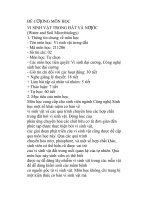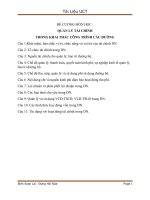Co2015 đề cương môn học
Bạn đang xem bản rút gọn của tài liệu. Xem và tải ngay bản đầy đủ của tài liệu tại đây (362.44 KB, 5 trang )
Đại Học Quốc Gia TP.HCM
Trường Đại Học Bách Khoa
Khoa KH&KT Máy Tính
Vietnam National University – HCMC
Ho Chi Minh City University of Technology
Faculty of Computer Science and Engineering
Đề cương môn học
LINH KIỆN VÀ MẠCH ĐIỆN TỬ
(ELECTRONIC DEVICES AND CIRCUIT)
Số tín chỉ
3 (2.2.5)
Số tiết
Tổng: 60
Mơn khơng xếp TKB
Tỉ lệ đánh giá
Hình thức đánh giá
MSMH
LT: 30
TH:
BT: 0%
TN: 30%
KT: 20%
- Kiểm tra: tự luận, 60 phút
- Thi: tự luận, 90 phút
CO2015
TN: 30
BTL/TL: 0
BTL/TL: 0%
Thi: 50%
Mơn tiên quyết
Mơn học trước
- Giải tích mạch cơ bản
EE2001
Mơn song hành
CTĐT ngành
Trình độ
Kỹ thuật Máy tính
Sinh viên năm 2
Ghi chú khác
1. Mục tiêu của môn học
Mục tiêu của môn học là cung cấp cho sinh viên:
1) Tri thức về cấu trúc và hoạt động của các linh kiện điện tử
2) Hiểu về các thiết bị như diode và transistors được mơ hình hố như thế nào và cách sử dụng
những mơ hình này để phân tích các mạch điện tử hữu dụng
3) Khả năng phân tích, mơ phỏng hoạt động và hiệu năng của các mạch điện tử ứng dụng
Aims:
The subject aims to provide the student with:
1) Knowledge about structure and operation of electronic devices
2) An understanding of how devices such as semiconductor diodes and transistors are modeled and
how the models are used in the analysis of useful circuits.
3) The capability to analyze and simulate behavior and performance of application electronic circuit
2. Nội dung tóm tắt mơn học
Mơn học bao phủ: cấu trúc của các linh kiện điện tử, mơ hình hố của các linh kiện điện tử, hiểu các
trường hợp sử dụng và giới hạn của các mô hình, và phân tích mạch cơ bản. Cùng với việc học tính
tốn trên giấy, các cơng cụ mơ phỏng cũng được dạy để giúp sinh viên hiểu lý thuyết sâu hơn cũng
như có thể kiểm chứng các phân tích mạch của họ. Các chủ đề trong khoá học được lựa chọn để phù
hợp nhất với các môn học theo sau trong ngành kỹ thuật máy tích, ngành tập trung chính vào thiết
kế các mạch số hơn là các mạch tương tự.
Course outline:
The course covers: construction of electronic devices, modeling of electronic devices,
understanding the uses and limitations of various models, and basic circuit analysis. Along with
paper-work study, simulation tools are taught to help students understanding theory more deeply as
we as verifying their circuit analysis. Topics in the course are selected to best fixed with followed
advanced courses in computer engineering field which almost focus on digital circuit rather than
1/5
analog circuit design.
3. Tài liệu học tập
Sách, Giáo trình chính:
[1] Robert Boylestad, Louis Nashelsky, Electronic devices and circuit theory, 11th edition, 2012
[2] Fonstad, Clifton. Microelectronic Devices and Circuits. 2006 Electronic Edition. Available
online at DSpace@MIT.
Sách tham khảo:
[3] Adel S. Sedra and Kenneth C. Smith, "Microelectronic Circuits," 5th Edition, Oxford
University Press, 2004
4. Hiểu biết,kỹ năng, thái độ cần đạt được sau khi học môn học
STT
1
2
3
4
5
6
INDEX
1
2
3
4
5
6
Chuẩn đầu ra môn học
Hiểu cấu tạo, nguyên lý hoạt động, mơ hình của các linh kiện điện tử chủ
yếu như diode, BJT và FET transistor
Xác định được các thông số thực và liên kết đến hoạt động vật lý của thiết
bị
Phân tích hoạt động ở trạng thái ổn định của các mạch điện tử ứng dụng cơ
bản như mạch khuyếch đại, mạch khuyếch đại thuật tốn
Phân tích đáp ứng tần số của một số mạch đơn giản
Biết cơ bản về một số mạch công suất
Sử dụng công cụ mơ phỏng SPICE để mơ hình các linh kiện mới, để vẽ
mạch, để mơ phỏng và để phân tích hoạt động của các mạch điện tử
CDIO
1.1.3
Course learning outcomes
Understand the construction, operating principles, models of major
electronic devices, such as diode, BJT, FET transistors
Identify practical parameters and connection to the physical operation of
devices
Analysis stable-state operation of electronic basis application circuits such
as amplifier, operational amplifier
Analysis frequency response of simplify circuits
Knowing basis high-power application circuits
Use SPICE simulation tool to modal new devices, to draw circuit, to
simulate and to analyze operating of circuits
CDIO
1.1.3
1.1.3
1.1.5
1.1.5
1.1.5
4.4.1
1.1.3
1.1.5
1.1.5
1.1.5
4.4.1
5. Hướng dẫn cách học - chi tiết cách đánh giá môn học
Sinh viên tham gia các buổi học lý thuyết, làm bài tập tại lớp và tại nhà. Sinh viên học kỹ năng mơ
phỏng, phân tích mạch để kiểm tra kết quả tính tay. Ngồi ra, sinh viên được phân vào các nhóm
thực hiện một bài tập lớn, thiết kế các mạch ứng dụng theo yêu cầu và sử dụng kết quả mơ phỏng để
chứng minh.
Bài tập: 0%
Thí nghiệm: 30%
Kiểm tra: 20%
Bài tập lớn/ Tiểu luận: 0%
Thi: 50%
2/5
Điều kiện dự thi:
Sinh viên phải tham dự giờ giảng trên lớp ít nhất 70% (số lần điểm danh ngẫu nhiên).
Sinh viên phải hoàn thành tất cả bài tập và thực hiện đầy đủ các công việc yêu cầu nộp kết quả
6. Dự kiến danh sách Cán bộ tham gia giảng dạy
TS. Phạm Hoàng Anh
Th.S Bùi Văn Hiếu
Th.S Nguyễn Tấn Phương
7. Nội dung chi tiết
LÝ THUYẾT
Tuần /
Chương
1
2
3
4
5
Nội dung
Chuẩn đầu ra
chi tiết
Hoạt động
đánh giá
Introduction
- Making connection between teacher and student
- Course-related information
- Semiconductor materials
- PN junctions
- Ideal diode
- Diode Equivalent Circuits
- Transition and Diffusion Capacitance
- Reverse Recovery Time
Diode and diode circuits
- Diode Specification Sheets
- Zener Diodes
- Series Diode Configurations with DC Inputs
- Sinusoidal Inputs; Half-Wave Rectification
- Full-Wave Rectification
- Clippers
- Clampers
- Voltage-Multiplier Circuits
BJT transistor and biasing
- Transistor Construction
- Transistor Operation
- Common-Base Configuration
- Common-Emitter Configuration
- Common-Collector Configuration
- Limits of Operation
- Operating Point
- Fixed-Bias Circuit
- Voltage-Divider Bias
BJT transistor modeling
- BJT Transistor Modeling
- The important parameters: Zi
, Zo, Av, Ai
- The re transistor Model
- The Hybrid Equivalent Model
- Graphical Determination of the h-parameters
- Transistor Specification Sheet
- Variations of Transistor Parameters
BJT circuit analysis
- Common-Emitter Fixed-Bias Configuration
3/5
Tuần /
Chương
6
7
8
9
10
11
12
13
14
15
Nội dung
Chuẩn đầu ra
chi tiết
Hoạt động
đánh giá
- Voltage-Divider Bias
- CE Emitter-Bias Configuration
- Emitter-Follower Configuration
- Common-Base Configuration
Field-effect transistor and biasing
- Construction and Characteristics
- Specification Sheets
- Fixed-Bias Circuit
- Self-bias configuration
- Voltage-Divider Bias
- FET Transistor Modeling
FET circuit analysis
- Fixed-Bias Configuration
- Self-Bias Configuration
- Voltage-Divider Configuration
- Source-Follower (Common-Drain) Configuration
- Common-Gate Configuration
BJT and FET frequency response
- General Frequency Considerations
- Low-Frequency Analysis
- Low-Frequency Response
- High-Frequency Response
- Multistage Frequency Effects
- Square-Wave Testing
Application circuits
- Switching circuit (saturation mode)
- General Techniques
- Propagation timing analysis
- Digital building-block circuits
- Determining the transfer characteristics
Operational amplifier (op-amp)
- Op-Amp Basics
- Op-Amp Specifications—DC Offset Parameters
- Op-Amp Specifications—Frequency Parameters
- Op-Amp Unit Specifications
- Practical Op-Amp Circuits
Op-amp applications
- Voltage Buffer
- Constant-Gain Multiplier
- Voltage Summing
Op-amp applications
- Instrumentation Circuits
- Active Filters
Introduction to high voltage circuit
- Small signal vs large signal
- Large signal model
- Miller Effect Capacitance
- Application circuits
Introduction to AC control circuit
- Construction of AC devices: SCR, Triac, Diac, Thyristor
- Trigger circuits
- Application circuits and operation
Review
THỰC HÀNH:
4/5
Tuần /
Chương
4
5
6
7
8
9
10
12
13
14
Nội dung
Chuẩn đầu ra
chi tiết
Hoạt động
dạy và học
Hoạt động
đánh giá
Introduction to SPICE software
Simulating BJT transistor biasing
(I,V) and developing new modal
Analyzing BJT application circuit
Analyzing BJT application circuit
(cont)
Simulating FET transistor biasing
and developing new modal
Analyzing FET application circuit
Analyzing frequency response of
circuits
Simulating operation of op-amp
application circuits
Simulating operation of op-amp
application circuits (cont)
Simulating operation of high-voltage
switching circuit
8. Thông tin liên hệ
Giảng viên:
Bộ môn:
Email:
Điện thoại
Giờ tiếp sinh viên:
Bùi Văn Hiếu
Kỹ thuật máy tính, tịa nhà A3
5/5









